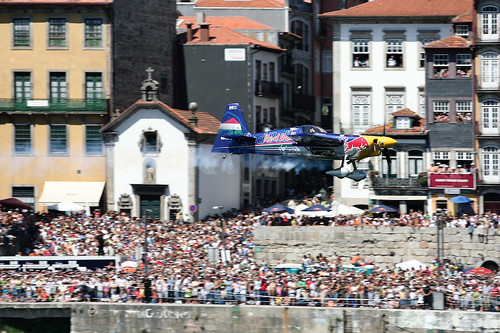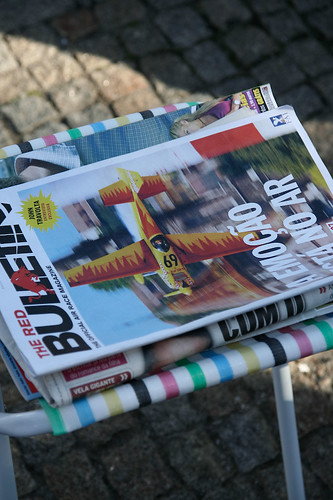 As you may already know, one of the Red Bull Air Race World Championship’s races will happen in Porto, on 6th and 7th September. It’s one of the ten cities to host this unique event, for the second time now. The first time was last year, 2007, as was a huge sucess both for viewers, organizers and for the hosting community.
As you may already know, one of the Red Bull Air Race World Championship’s races will happen in Porto, on 6th and 7th September. It’s one of the ten cities to host this unique event, for the second time now. The first time was last year, 2007, as was a huge sucess both for viewers, organizers and for the hosting community.
The race over the River Douro will be the eight of this season, which will be followed by a race in Spain (maybe in Vallencia, but still not confirmed, hapenning in September 27th and 28th) and the last one in Perth (Western Australia, in November 1st and 2nd).
 The race days in 2007 were compared to the S. João’s evening (in English, St. John), the traditional popular festival, in June, when thousands of people hang out on the streets of Porto and surroundings all night.
The race days in 2007 were compared to the S. João’s evening (in English, St. John), the traditional popular festival, in June, when thousands of people hang out on the streets of Porto and surroundings all night.
Photos: Tiago Pereira (click on the photos to enlarge)
Here’s a bit more of Red Bull Air Race in Portugal:
PORTO AND VILA NOVA DE GAIA – THE CITIES OF BRIDGES
TWO CITIES, ONE RIVER
The two cities of Oporto and Vila Nova de Gaia face each other from opposite sides of the Douro river – Oporto in the north bank and Gaia in the south. Six Pontes, or bridges, in total, join them. Of those, Ponte Dona Maria and Ponte Dom Luís, the two oldest ones, were built in the 19th century, respectively by Gustave Eiffel and by his partner in business, Théophile Seyrig. Ponte da Arrábida, Ponte de São João and Ponte do Freixo date from the 20th century, while the newest one, Ponte Infante Dom Henrique, is no older than the 21st century.
Being one of the oldest cities in Europe, Oporto is proud of its well preserved historical quarter and was awarded World Heritage Site status by UNESCO in 1996. Oporto and Gaia are further connected by the famous Oporto wine, traditionally stored in wine cellars that over the years have been built in Gaia and act as a magnet for tourists visiting Northern Portugal. There stand the names of the English families that left their winemaking mark in the Douro region over the centuries: Taylor, Sandeman, Graham or Croft, to name but a few.
Fine wine and the Douro River may be the lifeblood of the two cities, but visitors will also benefit from a widely varied cultural offer. The Serralves Foundation – with its vast collection of contemporary art and amazing gardens – the House of Music – a multidisciplinary place where you can listen to great music and much more – or Oporto Cathedral, dating from the 12th and 13th centuries, are some of the unmissable features north of the river. Also worth mentioning, on the south margin, are the Grijó Monastery (16 th/17th century), the Serra do Pilar Monastery (16th century) or Casa Barbot, a unique example of the Art Nouveau style in the city.
Oporto/Gaia – The race
The eighth leg of the Red Bull Air Race will be run over the river, in the Ribeira of Oporto and Gaia Docks area, on the weekend of the 6th and 7th September. The race course will be set between Ponte Dom Luís I and the Massarelos overpass.
This info was taken from Red Bull Air Race Official Website. Please check this website for information on accomodation, transportation to and from the places and ticket information as well. The website is available in Portuguese, Spanish, French and English.
You can also check the Red Bull Air Race Hospitality website to know more about the event.

There’s a magazine on each place available for download, containing information on the race, on the place and on previous relevant happenings. A bulletin will be distributed during the qualifying races and the final race days.
Photography: Tiago Pereira
Like this:
Like Loading...






